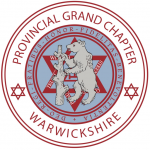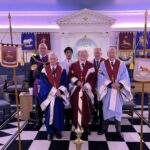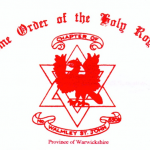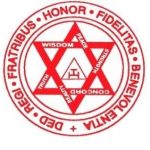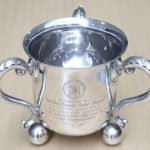CHAPTER OF FORTITUDE NO XL111
Companions,
It is of course very satisfactory and gratifying to me in the continuing discharge of my duties as the current 3rd Provincial Grand Principal to have the undoubted honour and privilege to submit to you a short oration on such a splendid occasion as the Bi-Centenary celebration of the Charter of Constitution of this most excellent of Chapters.
We are all aware and very proud that this is the eighth oldest RA Chapter under the English Constitution, being founded in 1783. As an aside, the Chapter of Charity No 187 in Bristol likes to describe itself as the “Oldest Chapter in the World”, having received its Charter from the Grand Chapter on 8th December 1769. But this as ever is disputed and depends very much upon the definition one chooses to use. The real distinction as to the Oldest Chapter probably lies with Stirling Rock Royal Arch Chapter No 2 in Scotland which has worked since 1743.
Interestingly, Lawrence Dermott’s “Ahiman Rezon” (which is usually considered to mean “Brother Secretary”) states that the degree was worked in London from at least 1744. Dermott it was after all who described Royal Arch Masonry as “the root, heart and marrow of Masonry”.
The point remains that Fortitude Chapter is certainly the Oldest Chapter in Warwickshire, even if there were two periods of dormancy, and that at various times it would appear to have been squabbled over by brethren of St. Paul’s Lodge, St Alban’s Lodge and Athol Lodge.
St Paul’s Lodge not unusually seems to have had warrants from both the ancients and the moderns and therefore depending which warrant they chose to use on a particular night they had the ability to undertake RA ritual within their own craft lodge and had no reason to have a separate RA Chapter. Athol lodges are by nature/association Ancient Lodges. The Grand Lodge of the Ancients Bernard E Jones was quick to point out was known as the Grand Lodge of the 4 degrees.
The English word “Fortitude” is derived from the latin “fortis” meaning strong, powerful, vigorous, steadfast, courageous and brave. There is also very much an underlying element of resolve over a long period of time.
How apt is the name fortitude for such a long lasting and independent Chapter?!
We can only wonder at all the changes that this chapter has seen over its long period of existence. Recently E. Comp Peter Mason, the past Deputy, G. Superintendent of the RA Province of Cumberland and Westmorland advised those present at the Warwickshire Installed First Principal’s meeting that there had been at least 243 significant changes to the RA ritual since the formation of the Supreme Grand Chapter in 1817! A huge number indeed and by that point this Chapter had already potentially been going for a third of a century!! So it met regularly on Sundays and the Principals wore headgear and joshua a breastplate in the early years of its existence.
Some of you, I am sure, are familiar with David West’s recent book (published 2020) called “The Enigma of the Royal Arch” where he says that the third degree and Royal Arch tales are satisfying on their own, but together they are incoherent, a secret never to be revealed is essentially incompatible with a secret engraved; one tale belies the other he would contend.
To elaborate, at our initiation we all solemnly promise to:-
Conceal and never reveal any part or parts, point or points, of the secrets or mysteries of or belonging to Free and Accepted Masons in Masonry, which may heretofore have been known by, shall now or may at any future time be communicated to (us).
And that we would not:-
Write those secrets, indite, carve, mark, engrave or otherwise delineate, or cause or suffer it to be done by others if in (our) power to prevent it, on anything moveable or immoveable under the canopy of heaven, whereby or whereon any letter character or figure or the least trace of any letter character or figure may become legible or intelligible to (ourselves) or anyone in the world.
Nevertheless, on our exaltation, we are expected to believe that on the orders of the original three Grand Masters these same secrets were engraved on a plate of gold. The implication is that when Solomon declared the Secrets of a Master Mason to be lost, he was telling a porky – certainly indulging in some evasion and equivocation and probably some mental reservation as well. Our “obligation” and “discovery” simply do not fit together.
It is perhaps fortunate that freemasonry is not a religion or David West might well have been burned at the stake for being a heretic for holding such forthright thoughts!
Is this sort of enigma helpful to us? Is the Sussex Fudge of the Preliminary Declaration really so difficult to live with? I would venture to suggest that Enigmas are not always bad things:-
The Mona Lisa is said to have an enigmatic smile and although Da Vinci spent supposedly over 15 years trying, he never considered the portrait finished. Yet millions over the years have felt obliged to travel to Paris to see said portrait hanging in the Louvre.
Turning slightly nearer to home and Worcestershire we have the example of Sir Edward Elgar’s (fourteen) Enigma Variations. Even Warwickshire Masons could never surely consider these as less than perfect in every particular?
Yes, the original score indicated the persons portrayed only by initials and one might surmise that their identities are the enigma of the title, yet Elgar freely named each person and indicated what he had hoped to portray about them.
And finally, by way of example, we have the infamous German 2nd World War enigma machine. The breaking of the codes of which is said to have shortened the War by at least a year and saved the lives of countless thousands of allied troops. The true enigma in that case being that the detailed drawings of the enigma machine itself (with usual German efficiency) had been lodged long before 1939 with the British Patent Office in London! The device being considered as a useful tool of commercial rather than state espionage.
So where does this all lead us to then?
Man is not simply a practical being but has an essential spiritual aspect to his nature. In the Royal Arch a candidate, without trespassing on the bounds of religion, is invited to explore further his spiritual awareness and his declared belief in a supreme being. Due to the foresight and striving of the founders of this Chapter this pursuit has been taking place for over two hundred years. A remarkable achievement by any standards! The lives and mental wellbeing of countless companions have been enhanced and enlightened by the completion of their journey in pure ancient masonry within this very Chapter. What a debt of honour and gratitude companions we owe to your predecessors who have steered this most worthy of crafts through stormy seas and numerous conflagrations of epic and historic proportions.
The fact that only a relatively small proportion of Craft Masons join and remain active Royal Arch Masons (probably overall only some 13%) should not of itself perhaps concern us too much. Yes, there are many elements to confuse us in relation to the fourth regular step in freemasonry and its juxtaposition and indissoluble link with the previous three steps. But this is why there has always been fewer RA Chapters than Craft Lodges! A recent mantra of the 3rd Grand Principal, E Comp Gareth Jones, is to strive for quality not just quantity in Royal Arch membership.
Fortitude Chapter clearly has that quality, is one of the few, and a great survivor at that. It has unusually used canal boats, trumpets, and connections with canal arches in the past to connect with operative masons and indeed the communities in which they thrive (and sadly sometimes tragically perish).
To finish this oration I can do no better than to steal (and slightly misquote) the words of the Grand Superintendent E Comp J.R. Napier in May 1962:- “The fact that this chapter has been in existence for more than now (two centuries) proves that Royal Arch Masonry has an appeal that is real and undying. This Chapter was well named “Fortitude” be that by chance or foresight and I am also in no doubt that those who are now responsible for its well-being are so very worthy of their great responsibility”. May this chapter for ever be as beautiful as the Temple of Solomon, peaceful as its Arc and sacred as the Holy of Hollies.
Comp. N.J. Hawkins PGStB
3rd Provincial Grand Principal
18th May 2022



